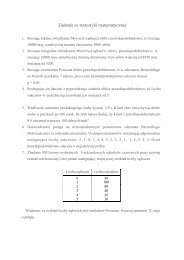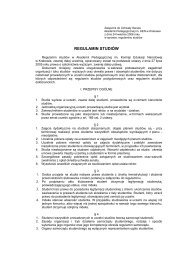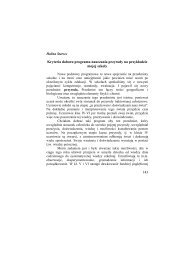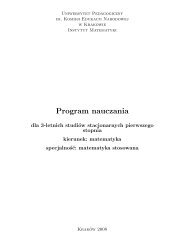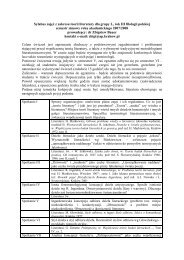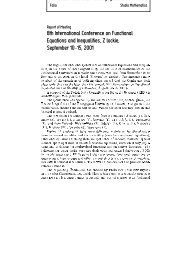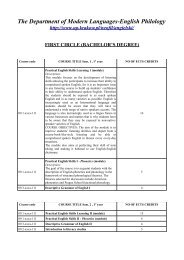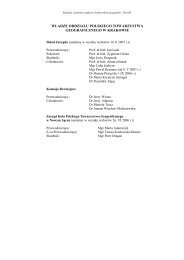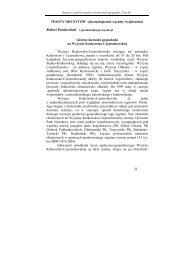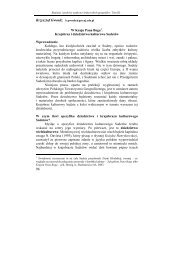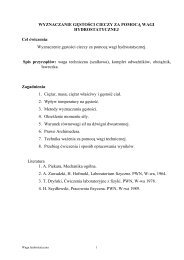Effect of Pd impurity on charge and spin density in metallic iron ...
Effect of Pd impurity on charge and spin density in metallic iron ...
Effect of Pd impurity on charge and spin density in metallic iron ...
Create successful ePaper yourself
Turn your PDF publications into a flip-book with our unique Google optimized e-Paper software.
1. Introducti<strong>on</strong><br />
The Mössbauer spectroscopy is sensitive to the electr<strong>on</strong> <strong>charge</strong> <strong>density</strong> <strong>on</strong> the res<strong>on</strong>ant nuclei<br />
via isomer shift, <strong>and</strong> it is simultaneously sensitive to the electr<strong>on</strong> <strong>sp<strong>in</strong></strong> <strong>density</strong> <strong>on</strong> the res<strong>on</strong>ant<br />
nuclei via dipolar magnetic hyperf<strong>in</strong>e <strong>in</strong>teracti<strong>on</strong> provided the sample rema<strong>in</strong>s magnetically<br />
ordered. Hence <strong>on</strong>e can look at the <strong>charge</strong> <strong>and</strong> <strong>sp<strong>in</strong></strong> <strong>density</strong> modificati<strong>on</strong>s due to the <strong>charge</strong><br />
<strong>and</strong> <strong>sp<strong>in</strong></strong> transfer from adjacent atoms surround<strong>in</strong>g the res<strong>on</strong>ant atom. If <strong>on</strong>e collects data at<br />
relatively low temperature <str<strong>on</strong>g>of</str<strong>on</strong>g> the sample <strong>in</strong>vestigated, i.e., well below magnetic order<strong>in</strong>g<br />
temperature <strong>on</strong>e looks approximately at the properties <str<strong>on</strong>g>of</str<strong>on</strong>g> the ground electr<strong>on</strong>ic state <str<strong>on</strong>g>of</str<strong>on</strong>g> the<br />
system. C<strong>on</strong>ducti<strong>on</strong> electr<strong>on</strong>s play dom<strong>in</strong>ant role <strong>in</strong> the <strong>charge</strong> <strong>and</strong> <strong>sp<strong>in</strong></strong> transfer <strong>in</strong> <strong>metallic</strong><br />
systems. A particularly simple situati<strong>on</strong> is achieved <strong>in</strong> a ferromagnetic host composed <str<strong>on</strong>g>of</str<strong>on</strong>g><br />
rather localised atomic magnetic moments provided res<strong>on</strong>ant atoms are <strong>on</strong>e <str<strong>on</strong>g>of</str<strong>on</strong>g> the host<br />
isotopes distributed r<strong>and</strong>omly between other n<strong>on</strong>-res<strong>on</strong>ant host atoms. Such situati<strong>on</strong> occurs<br />
<strong>in</strong> BCC ir<strong>on</strong>.<br />
In order to ga<strong>in</strong> some <strong>in</strong>formati<strong>on</strong> about the range <str<strong>on</strong>g>of</str<strong>on</strong>g> the <strong>charge</strong> <strong>and</strong> <strong>sp<strong>in</strong></strong> transfer between<br />
atoms <strong>on</strong>e can <strong>in</strong>troduce some n<strong>on</strong>-magnetic <str<strong>on</strong>g>impurity</str<strong>on</strong>g> distributed at r<strong>and</strong>om <strong>in</strong> the host. Low<br />
c<strong>on</strong>centrati<strong>on</strong>s <str<strong>on</strong>g>of</str<strong>on</strong>g> impurities are essential to avoid <strong>in</strong>teracti<strong>on</strong>s between them. Investigati<strong>on</strong> <str<strong>on</strong>g>of</str<strong>on</strong>g><br />
several samples with vary<strong>in</strong>g c<strong>on</strong>centrati<strong>on</strong> <str<strong>on</strong>g>of</str<strong>on</strong>g> impurities allows for better <strong>in</strong>sight <strong>in</strong>to the<br />
problem. An <str<strong>on</strong>g>impurity</str<strong>on</strong>g> affects <strong>charge</strong> <strong>and</strong> <strong>sp<strong>in</strong></strong> densities <str<strong>on</strong>g>of</str<strong>on</strong>g> the c<strong>on</strong>ducti<strong>on</strong> electr<strong>on</strong>s, <strong>and</strong> these<br />
perturbati<strong>on</strong>s have impact <strong>on</strong> the observed isomer shift <strong>and</strong> hyperf<strong>in</strong>e magnetic field. In the<br />
case <str<strong>on</strong>g>of</str<strong>on</strong>g> the very l<strong>on</strong>g distance perturbati<strong>on</strong>s <strong>on</strong>e sees the change <str<strong>on</strong>g>of</str<strong>on</strong>g> the average shift <strong>and</strong> field<br />
solely. Otherwise a distributi<strong>on</strong> <str<strong>on</strong>g>of</str<strong>on</strong>g> the shifts <strong>and</strong> fields builds-up with the <strong>in</strong>creas<strong>in</strong>g<br />
c<strong>on</strong>centrati<strong>on</strong> <str<strong>on</strong>g>of</str<strong>on</strong>g> diluted impurities due to various possible c<strong>on</strong>figurati<strong>on</strong>s around the res<strong>on</strong>ant<br />
atom [1].<br />
Ir<strong>on</strong>-palladium alloys have been already <strong>in</strong>vestigated <strong>in</strong> the past [2-5]. However no systematic<br />
<strong>in</strong>vestigati<strong>on</strong> <str<strong>on</strong>g>of</str<strong>on</strong>g> alloys rich <strong>in</strong> ir<strong>on</strong> has been performed up to now. We report here results,<br />
obta<strong>in</strong>ed for BCC ir<strong>on</strong> doped with palladium <strong>in</strong> the c<strong>on</strong>centrati<strong>on</strong> range extend<strong>in</strong>g from pure<br />
ir<strong>on</strong> till the alloy c<strong>on</strong>ta<strong>in</strong><strong>in</strong>g 10.59 at. % <str<strong>on</strong>g>of</str<strong>on</strong>g> palladium. The paper is organised as follows:<br />
secti<strong>on</strong> 2. describes experimental procedures applied, secti<strong>on</strong> 3. is devoted to the data<br />
evaluati<strong>on</strong>, while the last secti<strong>on</strong> 4. c<strong>on</strong>ta<strong>in</strong>s discussi<strong>on</strong> <str<strong>on</strong>g>of</str<strong>on</strong>g> results <strong>and</strong> c<strong>on</strong>clusi<strong>on</strong>s.<br />
2. Experimental<br />
Samples were prepared by arc melt<strong>in</strong>g under arg<strong>on</strong> atmosphere appropriate amounts <str<strong>on</strong>g>of</str<strong>on</strong>g><br />
natural ir<strong>on</strong> <strong>and</strong> palladium. Ir<strong>on</strong> <strong>in</strong>gots <str<strong>on</strong>g>of</str<strong>on</strong>g> 99.97+ % purity were obta<strong>in</strong>ed from Alfa Aesar.<br />
Palladium was obta<strong>in</strong>ed <strong>in</strong> form <str<strong>on</strong>g>of</str<strong>on</strong>g> the sheet hav<strong>in</strong>g purity 99.9 %. All samples were melted<br />
three times <strong>and</strong> rapidly cooled. A compositi<strong>on</strong> <strong>and</strong> homogeneity <str<strong>on</strong>g>of</str<strong>on</strong>g> each sample was checked<br />
with the help <str<strong>on</strong>g>of</str<strong>on</strong>g> electr<strong>on</strong> micro-probe <strong>and</strong> results are shown <strong>in</strong> Table I. Mössbauer samples<br />
were prepared by powder<strong>in</strong>g <str<strong>on</strong>g>of</str<strong>on</strong>g> the appropriate <strong>in</strong>gots with the help <str<strong>on</strong>g>of</str<strong>on</strong>g> diam<strong>on</strong>d file. Result<strong>in</strong>g<br />
powder was mixed with the epoxy res<strong>in</strong> <strong>and</strong> absorbers <strong>in</strong> the form <str<strong>on</strong>g>of</str<strong>on</strong>g> discs hav<strong>in</strong>g 26 mm<br />
2<br />
diameter were made subsequently. Approximately 30 mg/cm <str<strong>on</strong>g>of</str<strong>on</strong>g> ir<strong>on</strong> was used, while<br />
prepar<strong>in</strong>g absorbers. Spectra were collected at ambient temperature us<strong>in</strong>g commercial<br />
57<br />
Co(Rh) source hav<strong>in</strong>g 6 µm thickness <strong>and</strong> covered by the high purity beryllium w<strong>in</strong>dow <str<strong>on</strong>g>of</str<strong>on</strong>g><br />
0.5 mm thickness. The source was purchased from Ritverc G.m.b.H. A Kr/isopenthane filled<br />
proporti<strong>on</strong>al detector equipped with high purity beryllium w<strong>in</strong>dow <str<strong>on</strong>g>of</str<strong>on</strong>g> 0.3 mm thickness was<br />
used to collect data. The maximum total count rate was kept low enough to assure l<strong>in</strong>ear<br />
resp<strong>on</strong>se <str<strong>on</strong>g>of</str<strong>on</strong>g> the detector. Mössbauer data were collected <strong>in</strong> a double ramp round-corner l<strong>in</strong>ear<br />
velocity mode <strong>in</strong> 4096 channels us<strong>in</strong>g MsAa-1 spectrometer [6]. Natural ir<strong>on</strong> foil <str<strong>on</strong>g>of</str<strong>on</strong>g> high<br />
2



